How ADOSH helps prevent workplace accidents in Arizona
If you’re hurt on the job in Arizona, there is a workers’ compensation program put in place by the government to assist you. This program is designed to help you recover financially from your injuries and possible time off work.
Want to know more about the organization responsible for your workers’ compensation? Check out the answers to these frequently asked questions.
What is ADOSH?
The Arizona Division of Occupational Safety and Health (ADOSH) is the regulatory body charged with overseeing the health and safety of employees in the Grand Canyon State. These requirements were set forth in the Arizona Occupational Safety and Health Act of 1972.
ADOSH is a division of the Industrial Commission of Arizona (ICA). The agency operates under a plan approved by the U.S. Department of Labor.
Which employees fall Under ADOSH jurisdiction?
ADOSH’s jurisdiction applies to more than 2.2 million employees throughout the state of Arizona in both the public and private sectors. This gives the agency oversight over more than 130,000 public and private workplaces. Though the agency’s jurisdiction applies to state and local government employees, it does not apply to federal government employees.
Other occupational sectors that are excluded from ADOSH oversight include mining operations and employment on Native American reservations.
What are ADOSH’s areas of responsibility?
The plan under which the Arizona Division of Occupational Safety and Health operates stipulates 7 specific areas of responsibility:
- Boiler safety (As of July 2017, ADOSH no longer performs mandatory in-service boiler inspections, but the agency is still responsible for recommending and enforcing standards, regulations and amendments to the guidelines set forth in the Administrative Code Title 20 Chapter 5 Article 4: Arizona Boiler Rules.)
- Elevator safety
- Compliance with standards of the Federal Occupational Safety and Health Act (OSHA)
- Training classes and participation in other educational endeavors
- Complaints, referrals and administration of policies implemented by OSHA
- Oversight of voluntary workplace protection programs
- Data collection for occupational injuries, illnesses and fatalities in Arizona in collaboration with the Bureau of Labor Statistics
How does ADOSH decide which facilities to inspect?
ADOSH prioritizes its own inspections as well as those of third-party agencies that perform inspections at the organization’s behest. Potentially hazardous facilities that pose an imminent danger are the top priority, followed by facilities that have engendered an unusually high number of complaints or workers’ compensation claims. ADOSH also participates in programmed inspections.
ADOSH is charged with carrying out its mandate in an unbiased manner, so specific employers are never targeted for inspection. However, ADOSH can target specific employers for follow-up inspections. Note that Arizona state law prohibits ADOSH from notifying employers that an inspection is about to take place.
ADOSH does not have the authority to shut down employers even if the agency finds multiple safety or health violations. Inspectors assess monetary penalties for violations, and these payments go into Arizona’s General Fund.
What types of workplace accidents does ADOSH inspect?
The Arizona Division of Occupational Safety and Health requires all work-related fatalities, hospitalizations, amputations and eye losses to be reported. Work-related fatalities must be reported within 8 hours while other incidents must be reported within 24 hours. These reports will initiate an inspection.
ADOSH may also inspect workplaces where other types of accidents have taken place such as falls and trenching incidents or incidents that garnered a high degree of public interest.
What should an employer do if cited?
If an employer receives a citation from ADOSH as the result of an inspection, that citation must be posted publicly in the area where the transgression occurred so that it is visible to all employees who may have been affected by the violation. The employer will need to correct the violation and implement a program designed to keep the violation from reoccurring. The employer will also need to document these abatement actions in a letter or report to ADOSH.
Employers have the right to dispute citations and the penalties citations carry. To do so, an employer must provide ADOSH with written notice of an intent to contest within 15 days of receiving the complaint.
Employers may also request informal conferences with the ADOSH supervisor who issued the citation, but the informal conference must take place within the same 15-day period. If an employer is dissatisfied with the outcome of the informal conference, they are entitled to a hearing before an Administrative Law Judge.
Are ADOSH standards the same as OSHA standards?
For the most part, ADOSH standards are identical to OSHA standards. In addition to OSHA requirements, however, ADOSH also prohibits the use of short-handled hoes for agricultural workers as well as the use of PVC piping in the transport of compressed gases.
Questions and answers about compensation for a job-related accident, injury or illness in Arizona
How does ADOSH handle complaints?
Anyone can file a complaint about hazardous conditions in the workplace with the Arizona Division of Occupational Safety and Health. There is even a protocol for filing complaints anonymously.
When ADOSH receives a complaint, the complaint is forwarded to the appropriate agency personnel who will review the complaint’s validity as well as the seriousness of the hazard described to determine an appropriate response.
Follow up may consist either of a letter to the employer that describes the hazard and demands proof of its removal or it may involve an on-site inspection. In either event, the individual who complained will receive a letter from ADOSH describing the action.
Does ADOSH handle complaints involving job discrimination?
ADOSH handles complaints that deal with retaliatory workplace discrimination, which targets employees who’ve exercised their workplace rights. Note that these types of complaints cannot be filed anonymously and that the complaint must be filed with ADOSH within 30 days of the discriminatory incident. The complaint form must contain an accurate description of the alleged incident and specific evidence that supports the allegation.




